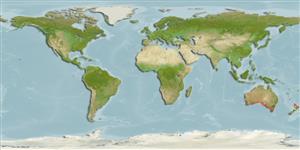Environment: milieu / climate zone / depth range / distribution range
Ecología
marino demersal; rango de profundidad ? - 60 m (Ref. 33616). Temperate; 28°S - 43°S
Eastern Indian Ocean: southern Australia, from Western Australia to New South Wales and Tasmania.
Tamaño / Peso / Age
Maturity: Lm ? range ? - ? cm
Max length : 20.0 cm SL macho / no sexado; (Ref. 33616)
Short description
Claves de identificación | Morfología | Morfometría
Espinas dorsales (total) : 8 - 9; Radios blandos dorsales (total) : 13 - 15; Espinas anales: 0; Radios blandos anales: 13 - 15; Vértebra: 30 - 31. Adults have scute-like lateral line scales, a prominent white-edged dark blotch on the first dorsal fin, a broad pale band on the caudal fin, and blackish green color on the inner surface of the large pectoral fins (Ref. 33616).
Found in bays and coastal marine waters, over the continental shelf (Ref. 33616).
Life cycle and mating behavior
Madurez | Reproducción | Puesta | Huevos | Fecundidad | Larva
Neira, F.J., A.G. Miskiewicz and T. Trnski, 1998. Larvae of temperate Australian fishes: laboratory guide for larval fish identification. University of Western Australia Press. 474 p. (Ref. 33616)
IUCN Red List Status (Ref. 130435: Version 2024-1)
Threat to humans
Harmless
Human uses
Pesquerías: sin interés
Herramientas
Can't connect to MySQL database fbquizv2. Errorcode: Too many connections
